대한언어학회 전자저널

-
Learning Syllable-timed Prosody as a Native Speaker of Stress-timed Prosody
-
Manner-Result Complementarity and the Serial Verb Construction in Korean
-
A Diachronic Study of the Positive Influences of Prescriptive Grammar
-
Positive Stripping Construction in English and Korean: A Direct Interpretation Approach
-
Identifying Suicide Notes Using Forensic Linguistics and Machine Learning
27권 2호 (2019년 6월)
- Learning Syllable-timed Prosody as a Native Speaker of Stress-timed Prosody
-
Jong-mi Kim
Pages : 87-107
Abstract
Keywords
# prosodic transfer # contrastive duration # contrastive pitch # English-speaking learners of Korean # pairwise variability # fundamental frequency # vowel duration # speech rhythm
References
- Abercrombie, D. (1967). Elements of general phonetics. Edinburgh, UK: Edinburgh University Press.
- Barry, W., Andreeva, B., & Koreman, J. (2009). Do rhythm measures reflect perceived rhythm? Phonetica 66, 78-94. DOI: 10.1159/000208932
- Behrman, A., Ferguson, S. H., Akhund, A., & Moeyaert, M. (2019). The effect of clear speech on temporal metrics of rhythm in Spanish-accented speakers of English. Language and Speech, 62(1), 5–29. DOI: 10.1177/0023830917737109
- Choo, M., & O\'Grady, W. D. (2003). The sounds of Korean: A pronunciation guide. Honolulu: University of Hawaii Press.
- Cumming, R. E. (2011). The language-specific interdependence of tonal and durational cues in perceived rhythmicality. Phonetica, 68, 1-25. DOI: 10.1159/000327223
- Deterding, D. (2001). The measurement of rhythm: a comparison of Singapore and British English. Journal of Phonetics, 29, 217-230.
- Gilbert, J. B. (2019). An informal account of how I learned about English rhythm. TESOL Journal e00441. DOI: 10.1002/tesj.441
- Grabe, E., & Low, E. L. (2002). Durational variability in speech and the rhythm class hypothesis. Papers in Laboratory Phonology, 7, 515-46.
- Jang, T.-Y. (2008). Speech rhythm metrics for automatic scoring of English speech by Korean EFL learners. Malsori, 66, 41-59. The Korean Society of Phonetic Sciences and Speech Technology.
- Jun, S.-A. (1998). The accentual phrase in the Korean prosodic hierarchy. Phonology, 15(2), 189-226.
- Jun, S.-A. (2005a). Korean intonational phonology and prosodic transcription. In S.-A. Jun (Ed.), Prosodic typology: The phonology of intonation and phrasing (pp. 201-229). Oxford: Oxford University Press.
- Jun, S.-A. (2005b). Prosodic typology. In S.-A. Jun (Ed.), Prosodic typology: The phonology of intonation and phrasing (pp. 430-458). Oxford: Oxford University Press.
- Jun, S.-A., & Oh, M. (2000). Acquisition of second language intonation. The Journal of the Acoustical Society of America, 107(5), 2802-2803. DOI: 10.1121/1.429024
- Kim, J.-M. (2005). Stress assignment rules in Korean English. Studies in Phonetics, Phonology and Morphology, 11(2), 247-258.
- Kim, J.-M. (2012). An accent reduction course for native speakers of American English learning Korean. Studies in Phonetics, Phonology and Morphology, 18(1), 27-50. DOI: 10.17959/sppm.2012.18.1.27
- Kim, J.-M. (2017). Prosodic transfer of speech rhythm: Substituting fundamental frequency for vowel duration in Korean learners’ English speech. Studies in English Language and Literature, 43(4), 181-203. DOI: 10.21559/aellk.2017.43.4.10
- Kim, J.-M., & Park, K.-M. (2018). Speaking a syllable-timed language as a native speaker of a stress-timed language. In Abstract Book of the 20th International Congress of Linguistics, 414.
- Kim, J.-M., Flynn, S., & Oh, M. (2007). Non-native speech rhythm: A Large-scale study of English pronunciation by Korean learners. Studies in Phonetics, Phonology and Morphology, 13(2), 219-250.
- Kochanski, G., Grabe E., Coleman, J., & Rosner, B. S. (2005). Loudness predicts prominence: Fundamental frequency lends little. Journal of the Acoustical Society of America, 118(2), 1038–1054.
- Korea Ministry of Culture, Sports and Tourism. (2014). Romanization of Korean. (Notice of Regulation, No. 2000-8, No. 2014-42). Retrieved March 28, 2019 from http://www.mcst.go.kr/english/koreaInfo/language/romanization.jsp
- Ladefoged, P., & Johnson, K. (2015). A Course in phonetics (7th edition). Boston, MA: Cengage Learning.
- Low, E. L., Grabe, E., & Nolan, F. (2000). Quantitative characterizations of speech rhythm: Syllable-timing in Singapore English. Language and Speech, 43(4), 377-401.
- Nolan, F., and Jeon, H.-S. (2014). Speech rhythm: a metaphor? Philosophical Transactions of the Royal Society B 369: 2013396. 1-10. DOI: 10.1098/rstb.2013.0396
- Ordin, M., & Polyanskaya, L. (2015). Acquisition of speech rhythm in a second language by learners with rhythmically different native languages. The Journal of the Acoustical Society of America, 138(2), 533-544.
- Pike, K. L. (1945). The intonation of American English. University of Michigan Papers in Linguistics I. University of Michigan, Ann Arbor.
- Roach, P. (1982). On the Distinction between ‘Stress-timed’ and ‘Syllable-timed’ languages. In D. Crystal (Ed.), Linguistic controversies (pp. 73-79). London: Edward Arnold.
- Scovel, T. (1988). A time to speak: A psycholinguistic inquiry into the critical period for human speech. New York: Newbury House.
- Shin, S. (2008). Read and speak Korean for beginners (1st ed.). McGraw-Hill.
- Tarone, E. (1988). Variation in interlanguage. London: Edward Arnold.
- Turk, A. E., & Shattuck-Hufnagel, S. (2007). Multiple targets of phrase-final lengthening in American English words. Journal of Phonetics, 35(4), 445-472.
- van Maastricht, L., Krahmer E., Swerts, M., & Prieto, P. (2018). Learning direction matters: A study on L2 rhythm acquisition by Dutch learners of Spanish and Spanish learners of Dutch. Studies in Second Language Acquisition, 1-35. DOI:10.1017/S0272263-118000062